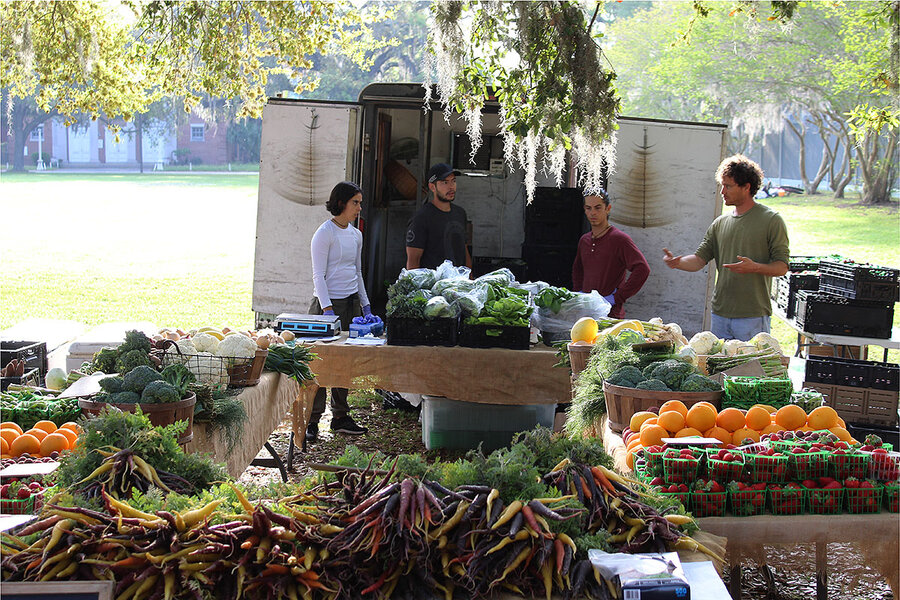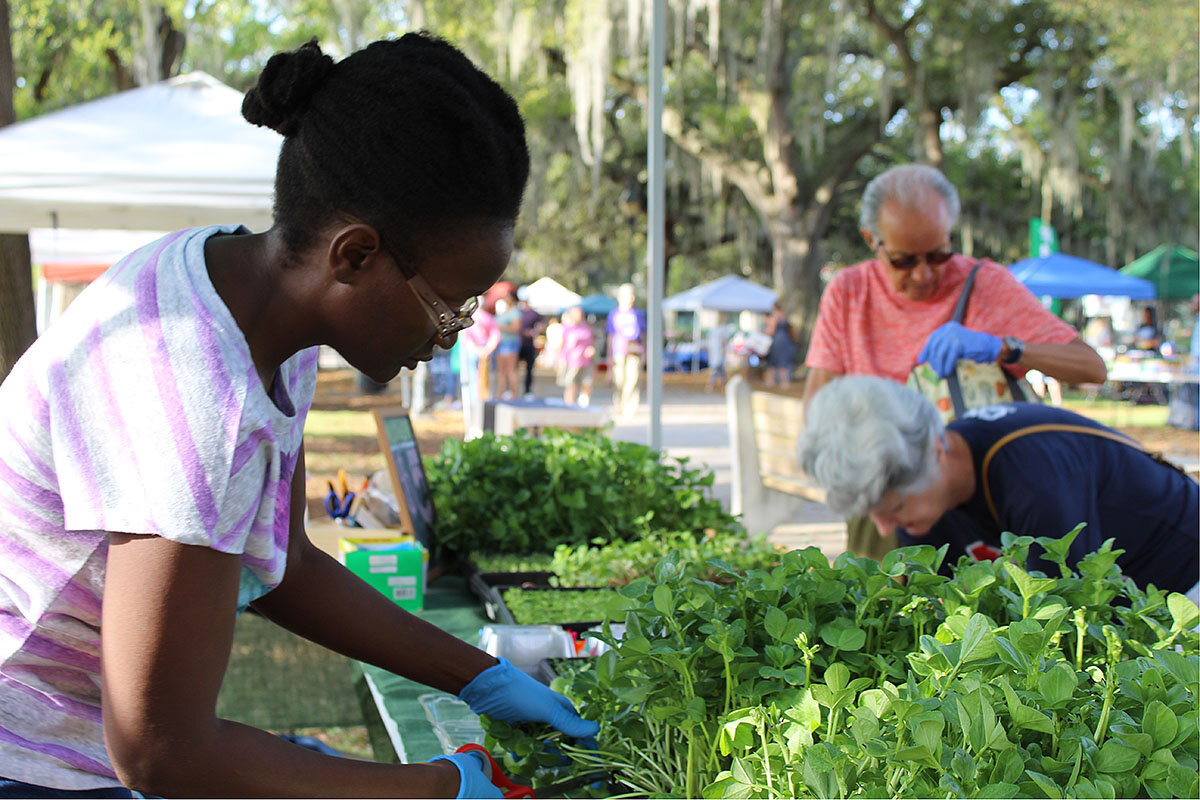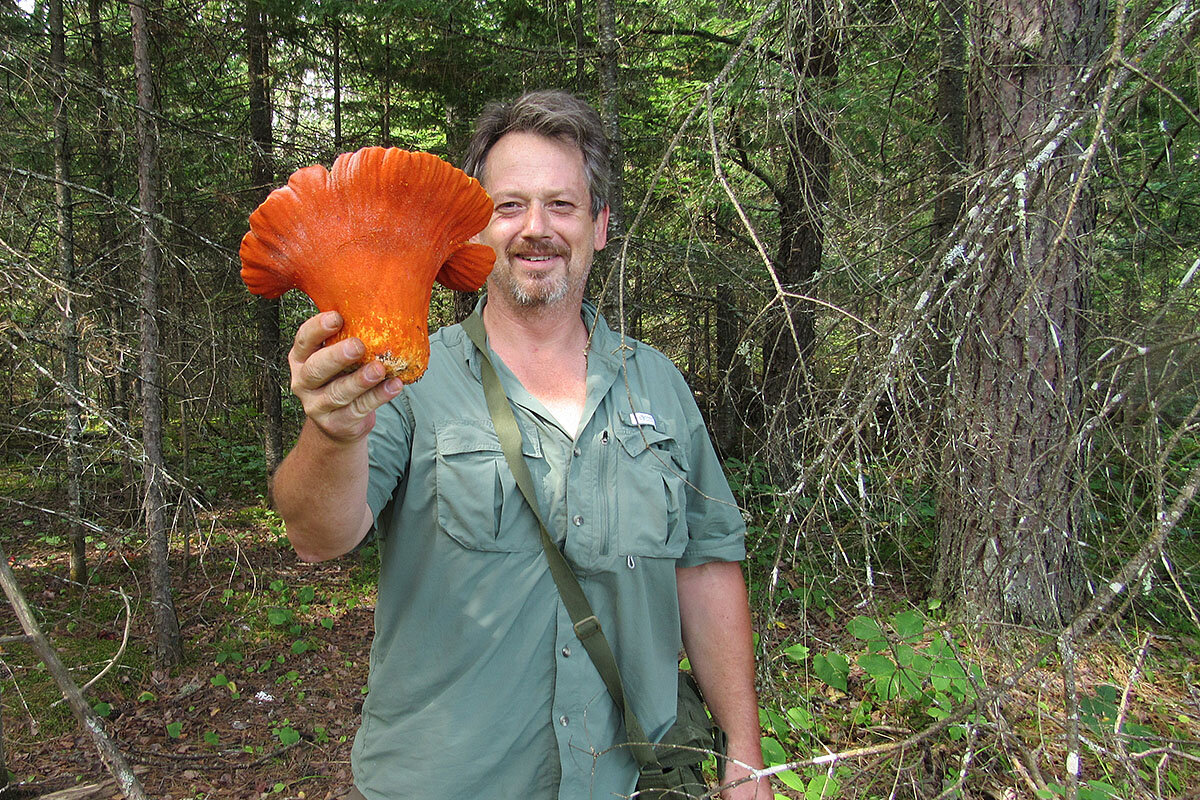Locavores were resetting the American table. Then came a pandemic.
Loading...
| Savannah, Ga.
As a morning sun filters through the live oak boughs overhanging the Forsyth Farmers’ Market, two lines quickly build to snap up Adam Mentzer’s bouquets of carrots and asparagus.
On any other day, the foot traffic would be a bonanza for his small organic farm, Adam’s Farm and Garden. But Mr. Mentzer’s brow is furrowed and his expression clipped.
Two weeks ago, this Savannah market barely opened as the city shuttered all nonessential businesses, saved at the last minute by an exemption. Meanwhile, trend-setting restaurants like Staplehouse in Atlanta have become soup kitchens to help out during the crisis.
Why We Wrote This
With farm-to-table restaurants takeout-only and many farmers markets closed, locavores are concerned that the pandemic could undo the progress of their movement. Others believe the crisis only highlights how vital local supply chains are.
“My warehouse is full, but my markets are disappearing,” says Mr. Mentzer. “I’m worried.”
Editor’s note: As a public service, all our coronavirus coverage is free. No paywall.
America’s globalized food supply chain is groaning under the weight of a national emergency. As the baskets overflowed on Saturday in the park, onions, potatoes, and meat were nonexistent at one Savannah-area Kroger.
Some of the nation’s best restaurants have turned from feeding the Instagram generation to feeding the newly unemployed. But behind a deepening struggle to keep kitchens open is another challenge: how to preserve the farm-to-table supply chains that have been changing how America eats. As restaurants close or go to takeout, producers are deeply worried about the ability of local farmers, foragers, and fishers to ride out the pandemic. But there is also a growing sense that the crisis is causing Americans to see new value in local foodscapes.
For many Americans, the term food insecurity is tied to class and income. But today it has become a larger, buzzing question across the continent.
“I wouldn’t blame the government for shutting the market down, but that would be like shutting down a lifeline for me right now,” says Alex Chamberlain, a laid-off restaurant server, at the market. “Is that scary? Yeah, that’s scary.”
The anxiety that has sparked hoarding behavior and temporary shortages is rooted in a food supply infrastructure designed more to push volume than to nimbly fill market demands. That means that despite America’s cornucopia, fears of scarcity remain.
“The food system today is built upon a lack of transparency: That’s how folks make money, in the arbitrage,” says Ben Deda, CEO of FoodMaven, a locavore logistics firm in Colorado Springs, Colorado. “But in a situation like this, you want there to be a transparent view of supply and demand to make sure that you don’t have artificial spikes in prices or supply. There is no true shortage of food right now, so there shouldn’t be this sense of fear. But food is at the base level of what you need. If people only fear they don’t have enough food, that creates a real dangerous situation.”
To be sure, supply chain experts say America has enough chicken in cold storage to feed a nation. But at trucking logistics firms like Allen Lund Company, color-coded tracking maps are lit up red across the United States, suggesting a “widespread shortage of capacity,” executive vice president Kenny Lund tells JOC.com, a logistics intelligence firm.
In California, farmworker unions are pushing farmers to take precautions in the field, not out of concern of contamination, but to keep critical workers – already in short supply – healthy.
“Food production is a strategic issue for the country,” says Daniel Stanton, author of “Supply Chain Management for Dummies.” The global food network “is great, because it gives us a huge number of choices at a relative low cost. But what you find is when there is a disruption anywhere, it causes a blip in the system. And when you have disruption everywhere, the only supply chains that really work are the ones you started with: simple, local production.”
From best year ever to “zero sales”
In Minneapolis, forager Mike Kempenich went from his best year ever in his Forest to Fork mushroom business to “zero sales” overnight as customers like the Keg and Case food hall closed down.
Yet in the midst of the turmoil, an 11-store grocery chain called Kowalski’s Markets bought his entire fungi stock. It’s part of an effort both to keep Mr. Kempenich’s small firm afloat and to make sure that shelves are stocked while many markets struggle to get trucks into the loading dock.
“This highlights the need for Minneapolis or any American city to localize their supply chains,” says Mr. Kempenich. “What I hope people do is take a step back and think, ‘Hey, we have an incredibly unique moment in history here ... where we can recognize the flaws that are so obvious and address them, and not just go back to business as usual.’”
Amelia Gay has seen privation, and this isn’t it. “Right now, I’m not worried about food for me and my family,” she says at the Savannah market. “Part of the reason for that is all the food I can see around me from all these other vendors.”
On hand: seasonal shad roe, locally butchered pork, cultivated mushrooms.
An immigrant from Angola, Ms. Gay lived through decades of civil war before moving to the U.S. Today, she and her husband, James Gay, run a small microgreens farm in Pooler, Georgia.
“The key for us right now is to be compassionate to counter that feeling of fear in people,” says Mr. Gay.
In Abingdon, Virginia, the local farmers market is shut down, but producers are switching to direct-to-consumer internet sales.
“Things are changing,” says market manager David McLeish, who owns a small wool-and-veggies farm called Dreamland Alpacas outside the city limits. “People are going to become even more aware of where their food comes from, and they will support local farmers even more.”
Victory in gardening
For many producers, their role in fighting the pandemic is taking on a patriotic glow.
“Our farmers are saying, ‘As long as there’s soil, I’m going to be growing,’” says Mary Elizabeth Kidd, communications manager at Georgia Organics in Atlanta, which helps connect farmers with consumers. “I have found such hope in their determination. And as an eater, it brings me a great sense of comfort that I know where to get eggs, some grains, and some big juicy tomatoes.”
That search for eddies of safety amid currents of fear has begun to drive policy. Colorado has made it easier to package inspected meats in order to streamline local supply chains. A growing number of states are listing farmers markets as essential to fighting the pandemic.
“States are loosening logistical bottlenecks to get food to where it needs to go, and that’s happening at the smaller producer level, too,” says Shelie Miller, a professor at the University of Michigan’s Center for Sustainable Systems in Ann Arbor.
In 2018, a survey of U.S. consumers showed roughly 60% to 70% are willing to pay more for food products in the “natural, ethical, enhanced or ‘less of’ categories” – at least a 10 percentage-point increase from two years earlier. But that was before millions of people lost their jobs.
Thousands of field-to-table chefs are currently cooking only at home. Some of them worry that the locavore movement will, in fact, retreat as America faces a recession in which commodities may shoulder out local niche products.
“I look at how slowly the culture of local foods was built in Atlanta, and I worry with a lot of restaurants that have those values going away, does Atlanta go backwards to the meat-and-potatoes city it’s been for 40 or 50 years?” says Josh Hopkins, a former executive chef at Empire State South in Atlanta.
Yet times of crisis can also clarify the bonds between consumers and local suppliers, says Alan Muskat, an Asheville, North Carolina, “philosoforager” and educator.
“What goes to the heart of the challenge and possibility now is fear versus love,” says Mr. Muskat, who leads guided mushroom hunts across the Appalachian Highlands. “The hunter-gatherer and fisherman see real abundance ... [and] realize we don’t have to be afraid [of going hungry]. If we stay afraid, it’s possible we go more in a direction of autocratic centralization [of the food supply]. But if we recognize this is a Garden of Eden even now and we can all feed each other locally if we share, then it’s very clearly laid out – it’s a bottom-line choice that this virus makes obvious.”
Editor’s note: As a public service, all our coronavirus coverage is free. No paywall.








